The Coathanger is an asterism located in the northern constellation Vulpecula (the Fox). With an apparent magnitude of 3.6 and an apparent size of 60 arcminutes, it is visible to the unaided eye on a clear night. The chance alignment of stars is also known as Al Sufi’s Cluster or Brocchi’s Cluster. It is catalogued as Collinder 399 in Per Collinder’s catalogue of open clusters.
The Coathanger asterism is composed of 10 stars that are not physically associated with each other. Six of these stars appear in a row, about 1.3 degrees across, and the remaining four complete the pattern of a coat hanger with a hook.
The brightest stars of the Coathanger shine at fifth magnitude and the faintest at seventh magnitude, making the asterism just visible to the unaided eye in clear, dark skies. The star pattern appears as an elongated fuzzy patch of light. Binoculars and small telescopes reveal the individual stars and the coat hanger pattern.
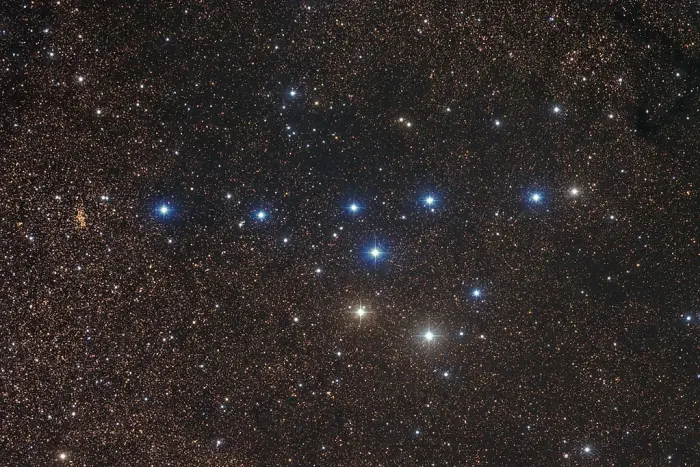
The Coathanger, image credit: Petr Novák (CC BY-SA 4.0)
The Coathanger stars were long believed to form an open star cluster. A 1970 study found that the brightest six stars formed an open cluster while the fainter four did not. However, the study was based on imprecise data.
Observations with the Hipparcos satellite in 1997 confirmed that the stars were not gravitationally bound but only appeared in the same line of sight when seen from Earth.
About 30 fainter stars appear in the same field of view. Some observers consider them to be part of the Coathanger, while others do not. Unlike constellations, asterisms are not formally defined and the number of stars that form them may differ depending on the observer.
Facts
The Coathanger is also known as Al Sufi’s Cluster and Brocchi’s Cluster. The asterism predates the constellation Vulpecula, which was not created until the late 17th century. The Coathanger was first described by the 10th century Persian astronomer Al Sufi in his Book of Fixed Stars (964). Al Sufi described the object as a nebula that contained fourth, fifth and sixth magnitude stars.
Italian astronomer Giovanni Battista Hodierna independently discovered the object in the 17th century.
The name Brocchi’s Cluster is more recent. It refers to Dalmero Francis Brocchi, an amateur astronomer who contributed star charts and an atlas for the American Association of Variable Star Observers (AAVSO) in the 1920s. Brocchi created more than 500 comparison charts to guide variable star observers and for use in calibrating photometers.
In 1931, Swedish astronomer Per Collinder included the object in his catalogue of open clusters.
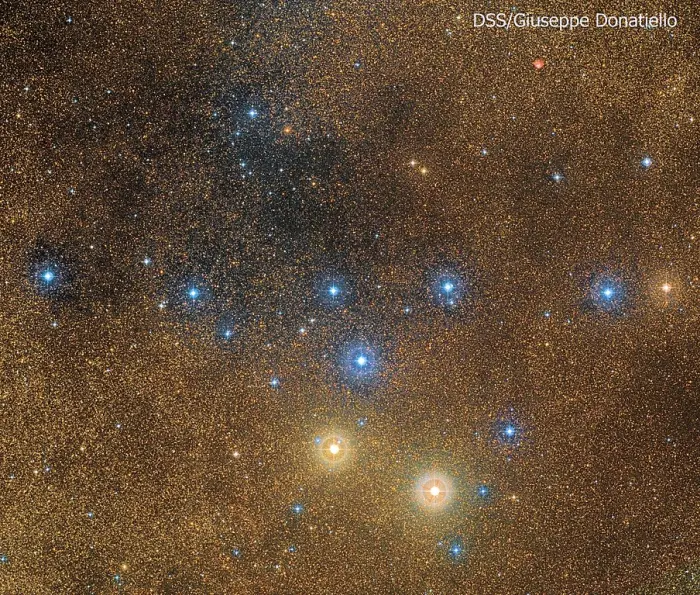
The Coathanger, image credit: POSS II / Giuseppe Donatiello (CC0 1.0)
Stars
The ten stars that form the Coathanger are (in order of brightness): 4 Vulpeculae (HD 182762, mag. 5.16), 5 Vulpeculae (HD 182919, mag. 5.60), HD 182955 (mag. 5.87), HD 182761 (mag. 6.29), 7 Vulpeculae (HD 183537, mag. 6.33), HD 182422 (mag. 6.39), HD 182972 (mag. 6.63), HD 183261 (mag. 6.88), HD 182293 (mag. 7.11), and HD 182620 (mag. 7.16).
The stars have a wide range of masses, sizes and temperatures. The brightest star, 4 Vulpeculae, is a cool orange giant. It is one of the several evolved stars in the visual grouping, along with the K-type subgiant HD 182293, the red giant HD 182955, and the hot blue bright giant HD 183261.
5 Vulpeculae, HD 182620, HD 182761, and HD 182972 are A-type main sequence stars, and HD 182422 and 7 Vulpeculae are hot, blue B-type main sequence stars.
The stars lie at very different distances. The brightest ones, 4 and 5 Vulpeculae, are the closest to us, located 255.8 and 235.3 light-years away.
The three luminous B-type stars – HD 183261, HD 182422, and 7 Vulpeculae – are the most distant. They lie 1,735, 1,124, and 910 light-years away, respectively. These stars will have the shortest lives of the group. They will burn through their supply of fuel much faster due to their high mass. (HD 183261 already has.) Depending on their exact mass, they will end their lives either as supernovae or massive white dwarfs surrounded by planetary nebulae.
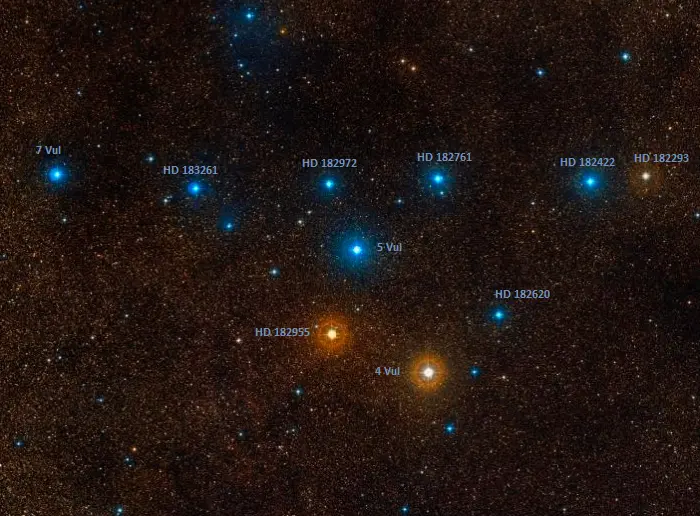
The Coathanger stars, image: Wikisky (DSS2)
Location
The Coathanger appears in the southern part of the faint constellation Vulpecula (the Fox), near the border with Sagitta (the Arrow). It lies in the region of the Summer Triangle, formed by the bright Deneb in the constellation Cygnus (the Swan), Vega in Lyra (the Lyre), and Altair in Aquila (the Eagle). The asterism can be found next to the constellation figure of Sagitta, near Albireo at the base of the Northern Cross in Cygnus. It lies about a third of the way from Altair to Vega.
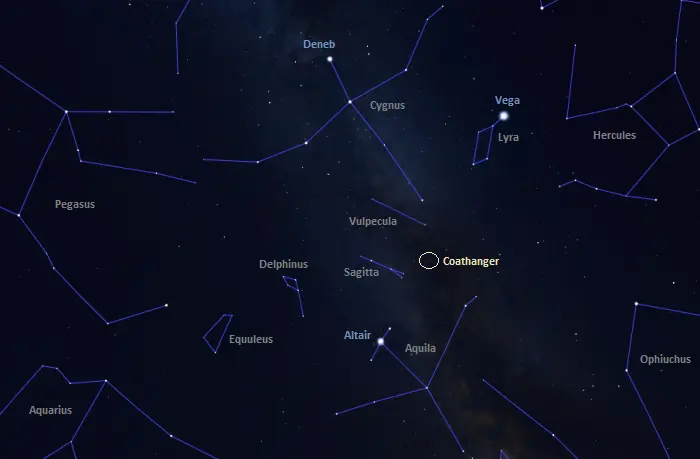
The location of the Coathanger, image: Stellarium
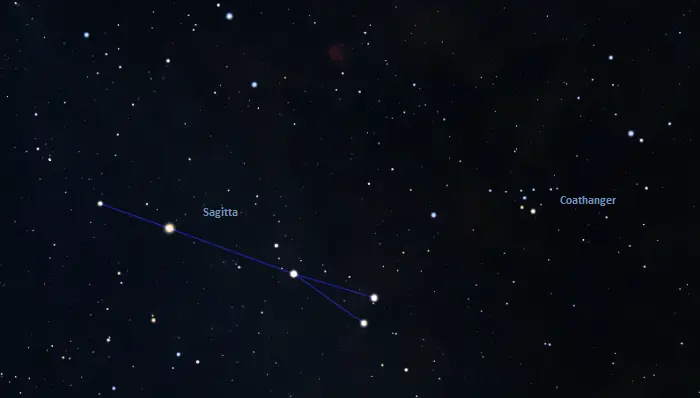
The Coathanger location, image: Stellarium
A small open cluster, NGC 6802, appears in the same area. Unlike the stars of the Coathanger, it is a true open cluster, one that lies at a greater distance than the visual group. The most recent measurements place the cluster 4,420 light-years away.
NGC 6802 can be found by following the rail of the coat hanger. The cluster shines at 9th magnitude and has an apparent size of around 5 arcminutes. It was discovered by William Herschel on September 22, 1783.
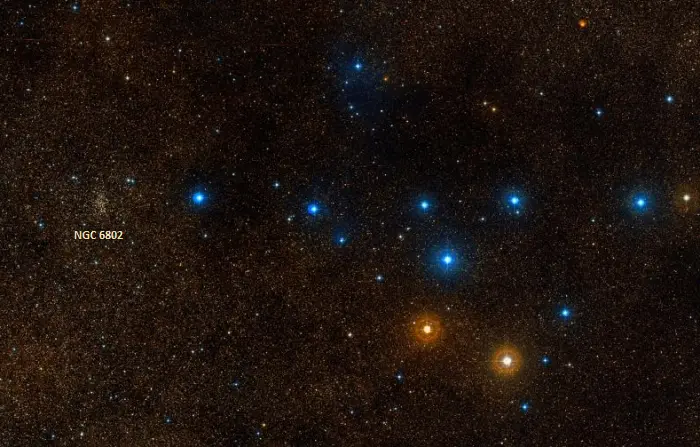
The Coathanger and NGC 6802, image: Wikisky (DSS2)
The Coathanger and other objects in Vulpecula are best seen during the month of September, when the constellation appears higher in the sky in the early evening.
The Coathanger – Brocchi’s Cluster
| Constellation | Vulpecula |
| Object type | Asterism |
| Right ascension | 19h 25m 24s |
| Declination | 20° 11′ 00″ |
| Apparent magnitude | 3.6 |
| Apparent size | 60 arcminutes |
| Names and designations | The Coathanger, Al Sufi’s Cluster, Brocchi’s Cluster, Collinder 399, Cr 399 |
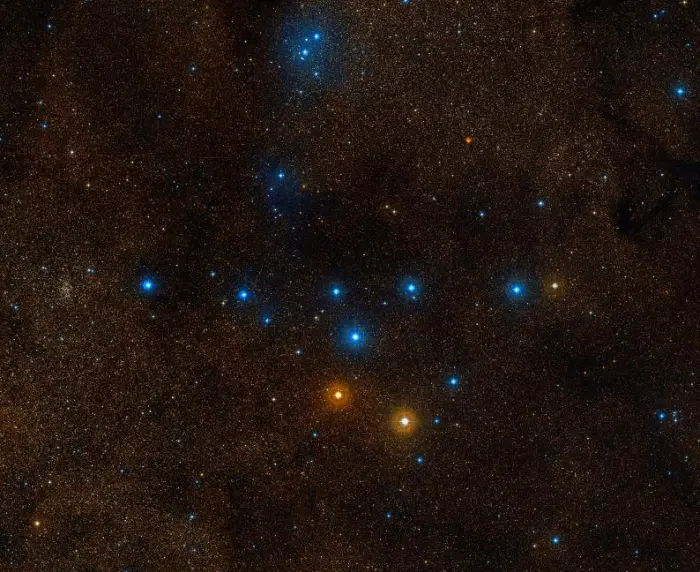
The Coathanger, image: Wikisky (DSS2)